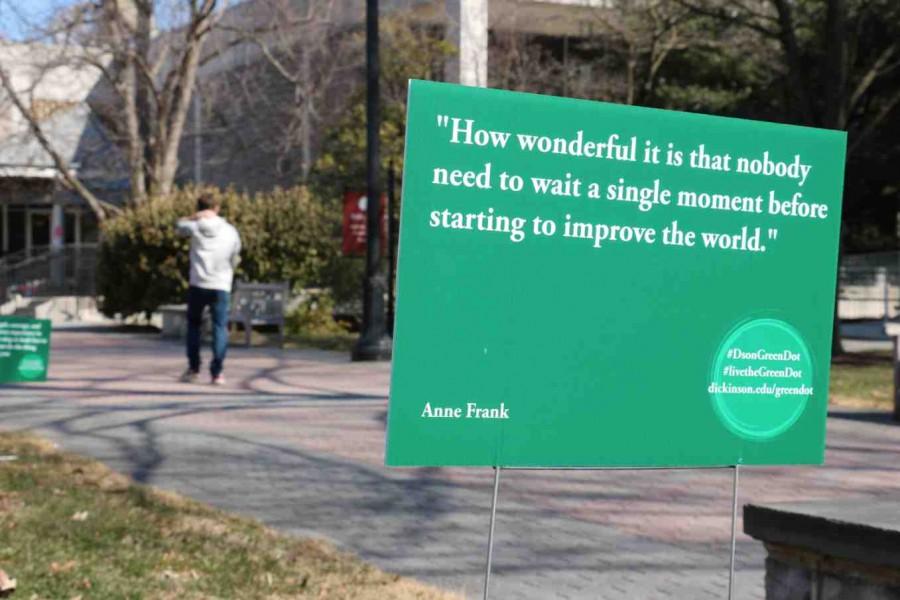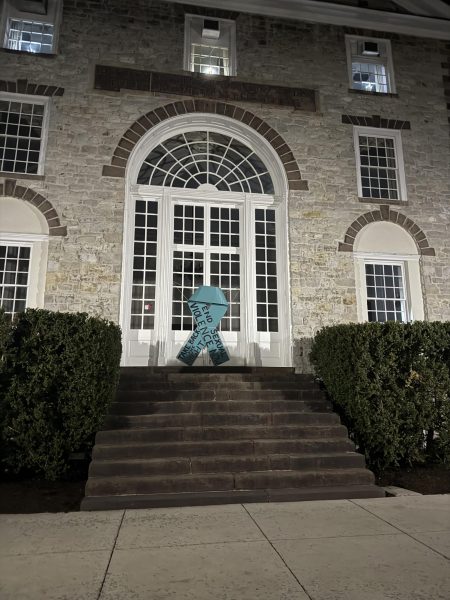“We Are All Part of the Solution”
College joins state wide campaign to prevent sexual assault
Dickinson has officially pledged its commitment to the state wide “It’s On Us PA” campaign, which aims to raise awareness of sexual violence on college campuses and calls on students, administrators and faculty to play a role in ending sexual assault. Under Governor Tom Wolf, Pennsylvania became the first state to adopt a statewide version of the campaign, which is a national effort supported by President Barack Obama.
As a result of its involvement in the campaign, the college will increase the number of prevention advocacy programs available to students and faculty. The new programs will range from bystander intervention training to film screenings, one of which was The Hunting Ground, a documentary about college sexual assault that was shown on March 3.
Dickinson athletics and the Student Athletic Advisory Committee have also joined in the movement, and produced a short video featuring student athletes and staff speaking in support of the campaign.
In recent weeks, these programs have also helped increased awareness of Sexual Assault Awareness Month, which is observed every April.
According to Kelly Wilt, director of the Prevention, Education and Advocacy Center (PEAC), Dickinson has decided to participate in the It’s On Us campaign “to get people to take responsibility in taking part to prevent sexual violence.”
“Sexual assault is not someone else’s problem,” said Donna Greco, Title IX coordinator. “It affects all of us. And we are all part of the solution.”
According to Dickinson’s Annual Security and Fire Safety Report, in 2014 the college received seven reported cases of rape, three cases of fondling and nine cases of stalking. These statistics are available to the public, as required by the Jeanne Cleary Disclosure of Campus Security Policy and Campus Crime Statistics Act, and the Violence Against Women Act.
However, these statistics only reflect cases “reported to DPS, local law enforcement and campus security authorities… The statistics do not reflect any reports that might have been made to other departments or individuals… Professional counselors, when acting as a counselor, are not required to report any crimes or incidents,” according to the report. These numbers do not represent all cases of sexual violence on campus.
Wilt estimated that upwards of 80 percent of sexual misconduct cases go unreported, “especially on college campuses.”
“All colleges have to report [their incidences of misconduct], but that number is so small [due to] the qualifying requirements that have to take place… that’s where statistics get really tricky,” said Wilt.
In an effort to gather more accurate statistics, PEAC circulated a sexual assault climate survey in spring 2015 within the Dickinson community for students to anonymously report their experiences of sexual assault.
“We’re still going to have underreporting, but I think that we’re likely to get a more reflective sample of folks who have actually experienced sexual assault,” said Wilt.
The survey was conducted by an outside group that reported the information to Dickinson in the fall. PEAC has been working with a group of mostly students and some faculty to process the information with plans to make the data available in summer 2016.
In recent years, however, Wilt has seen an increase in the number of students reporting to her personally, which she attributes not to an increase in rates of sexual assault, but to the college “doing a better job at letting people know that there are resources and supports available if they want to report.”
“Formal [misconduct] processes are hard to go through, even when you have the best system,” said Wilt. “Most students aren’t interested in pursuing a misconduct process. They really want counseling support and maybe a no contact order so that person won’t have contact with them.”
Most students do not wish to pursue action through criminal court, which is why many colleges put significant resources into sexual assault support programs. Dolores Danser, director of the Department of Public Safety, said in the 10 years she has been at Dickinson, “it’s been a small handful of people who even consider going through criminal court process.”
“Providing confidential advocacy support to students… has always been happening, but we’re emphasizing different resources and trying to make sure folks know where they go for… support,” said Wilt.
Dickinson recently changed its investigative model to the use of an investigative team composed of an external investigator and someone within the college.
“It really is good to have a trained expert conduct investigations,” said Wilt.
According to Wilt, the college has also eliminated the step in the misconduct process that required the defendant and the complainant to “go into a room together and essentially cross examine.”
“That was a poor model that schools had in the past,” said Wilt.
Once students are interviewed, an investigative report is made and put out to a panel of faculty and staff who reflect on the report and issue sanctions if someone is found guilty.
“I know that students… are more interested in potentially pursuing an investigation knowing that they do not have to tell their story in front of the person they are accusing… In that respect, and in a lot of respects I think it’s a really good change,” said Wilt.
In addition, Dickinson recently revised their sexual misconduct policy in response to evolving mandates from the state and input from the Dickinson community.
“All schools are facing challenges in doing this work well,” said Wilt. “I think that there’s continued new guidance coming out on a regular basis and it’s saying ‘well now you should do this, something you’re doing in the past should be updated or revised.’” The policy is now “more accessible,” she said. It has been shortened from 60 to about 40 pages, and a summary of the policy is displayed around campus on posters.
“Do I think it’s perfect? No, but do I think we have a really strong policy and support in place for students,” said Wilt. “Our policy and procedures are used by a lot of schools as models for revising their policies.”
“I think we’ve done a better job at letting folks know that reporting sexual assault doesn’t necessarily mean that you have to go through the college’s misconduct system,” said Wilt. “You could report it just because you want someone to know and you want help. I think that we’ve really shifted it to show… this [process] is driven by you… what do you need?”
For more information on Dickinson’s Sexual and Relationship Violence Resources or to view the current Sexual Misconduct Policy, visit www.dickinson.edu/homepage/627/violence_prevention_resources.






